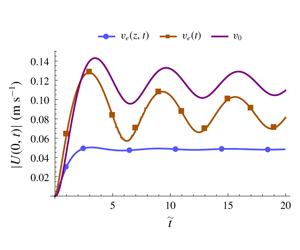Crossref Citations
This article has been cited by the following publications. This list is generated based on data provided by
Crossref.
Shrira, V. I.
and
Almelah, R. B.
2020.
What do we need to Probe Upper Ocean Stratification Remotely?.
Radiophysics and Quantum Electronics,
Vol. 63,
Issue. 1,
p.
1.
Grisouard, Nicolas
and
Zemskova, Varvara E.
2020.
Ekman-inertial instability.
Physical Review Fluids,
Vol. 5,
Issue. 12,
Lenain, Luc
and
Pizzo, Nick
2020.
The Contribution of High-Frequency Wind-Generated Surface Waves to the Stokes Drift.
Journal of Physical Oceanography,
Vol. 50,
Issue. 12,
p.
3455.
Higgins, C.
Vanneste, J.
and
van den Bremer, T. S.
2020.
Unsteady Ekman‐Stokes Dynamics: Implications for Surface Wave‐Induced Drift of Floating Marine Litter.
Geophysical Research Letters,
Vol. 47,
Issue. 18,
Chen, Hui
Li, Shaofeng
Song, Jinbao
and
He, Hailun
2021.
Wave-Modified Ekman Current Solutions for the Time-Dependent Vertical Eddy Viscosity.
Journal of Marine Science and Engineering,
Vol. 9,
Issue. 6,
p.
664.
Yu, Xiaolong
Ponte, Aurélien L.
Lahaye, Noé
Caspar‐Cohen, Zoé
and
Menemenlis, Dimitris
2021.
Geostrophy Assessment and Momentum Balance of the Global Oceans in a Tide‐ and Eddy‐Resolving Model.
Journal of Geophysical Research: Oceans,
Vol. 126,
Issue. 10,
Liu, Lei
Xue, Huijie
and
Sasaki, Hideharu
2021.
Diagnosing Subsurface Vertical Velocities from High-Resolution Sea Surface Fields.
Journal of Physical Oceanography,
Vol. 51,
Issue. 5,
p.
1353.
Morales‐Márquez, Verónica
Hernández‐Carrasco, Ismael
Simarro, Gonzalo
Rossi, Vincent
and
Orfila, Alejandro
2021.
Regionalizing the Impacts of Wind‐ and Wave‐Induced Currents on Surface Ocean Dynamics: A Long‐Term Variability Analysis in the Mediterranean Sea.
Journal of Geophysical Research: Oceans,
Vol. 126,
Issue. 9,
Fraunie, Philippe
2021.
Numerical investigation of mesoscale coherent structures in Mediterranean sea.
p.
162.
Wirth, Achim
and
Lemarié, Florian
2021.
Jarzynski equality and Crooks relation for local models of air–sea interaction.
Earth System Dynamics,
Vol. 12,
Issue. 2,
p.
689.
Lilly, Jonathan M.
and
Elipot, Shane
2021.
A Unifying Perspective on Transfer Function Solutions to the Unsteady Ekman Problem.
Fluids,
Vol. 6,
Issue. 2,
p.
85.
Roberti, Luigi
2022.
The surface current of Ekman flows with time-dependent eddy viscosity.
Communications on Pure and Applied Analysis,
Vol. 21,
Issue. 7,
p.
2463.
Buzzicotti, Michele
2023.
Data reconstruction for complex flows using AI: Recent progress, obstacles, and perspectives.
Europhysics Letters,
Vol. 142,
Issue. 2,
p.
23001.
Su, Fenzhen
Fan, Rong
Yan, Fengqin
Meadows, Michael
Lyne, Vincent
Hu, Po
Song, Xiangzhou
Zhang, Tianyu
Liu, Zenghong
Zhou, Chenghu
Pei, Tao
Yang, Xiaomei
Du, Yunyan
Wei, Zexun
Wang, Fan
Qi, Yiquan
and
Chai, Fei
2023.
Widespread global disparities between modelled and observed mid-depth ocean currents.
Nature Communications,
Vol. 14,
Issue. 1,
Johnson, R. S.
2023.
A theory for oceanic gyres based on Ekman flows using the thin-shell approximation with weak nonlinearity.
Monatshefte für Mathematik,
Vol. 202,
Issue. 4,
p.
807.
Torres-Herrera, Ulises
Keramat, Alireza
and
Duan, Huan-Feng
2024.
A theoretical framework for robust implementation of in situ measurements of ocean currents and waves in dynamics of mooring systems.
Physics of Fluids,
Vol. 36,
Issue. 9,
Guan, Yi
2024.
The atmospheric Ekman flows with time-dependent eddy viscosity.
Dynamics of Atmospheres and Oceans,
Vol. 108,
Issue. ,
p.
101496.
Wunsch, Carl
2024.
A time-average ocean: Thermal wind and flow spirals.
Progress in Oceanography,
Vol. 221,
Issue. ,
p.
103206.
El-Nabulsi, Rami Ahmad
and
Anukool, Waranont
2024.
A fractal approach to ocean Ekman transport.
Dynamics of Atmospheres and Oceans,
Vol. 106,
Issue. ,
p.
101459.
Llorente, Víctor J.
Padilla, Enrique M.
and
Díez-Minguito, Manuel
2024.
Sensitivity of boundary layer features to depth-dependent baroclinic pressure gradient and turbulent mixing in an ocean of finite depth.
Ocean Modelling,
Vol. 189,
Issue. ,
p.
102359.

 ${\sim}10^{2}~\text{m}$) spatial scales and can be very fast compared to the inertial period, which suggests spikes of dramatically enhanced mixing localized in the vicinity of the water surface. This picture is incompatible with the Ekman paradigm and thus prompts radical revision of the Ekman-type models.
${\sim}10^{2}~\text{m}$) spatial scales and can be very fast compared to the inertial period, which suggests spikes of dramatically enhanced mixing localized in the vicinity of the water surface. This picture is incompatible with the Ekman paradigm and thus prompts radical revision of the Ekman-type models.
